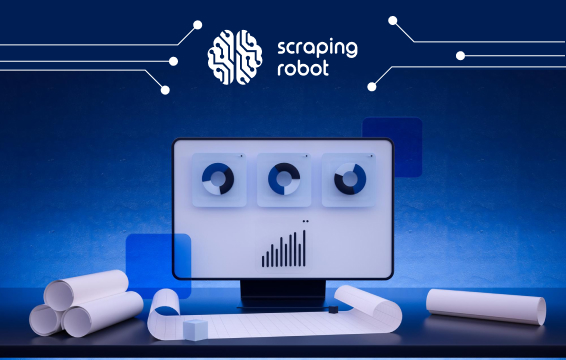SaaS Analytics (What You Need to Know To Get Started)

As a company that specializes in software as a service (SaaS), you’re most likely in the market for a simple solution that can help analyze your customer/subscriber’s behavior, right? Identifying what your ideal customer looks like in terms of their engagement, user activity, and your overall revenue is a crucial component to running a SaaS company. Web scraping can collect all that data in one fell swoop. Data is a vital resource, and using the best tools to collect it is a valuable resource. Web scraping is an automated way to collect, organize, and structure your data collection. And if you need data to fuel your programs and processes, a scraping API can collect that data and also funnel it directly into your programs.
This article will explore some data-driven SaaS approaches and strategies and how web scraping and data extraction can make that process more efficient and robust. In this article, we will answer your most commonly asked questions about SaaS analytics and why your company should use them. If you have a specific question in mind, please feel free to utilize our helpful table of contents listed below.
Table of Contents
2. Saas Data Analytics (Three Main Stats You Have to Look For)
3. What Are SaaS Predictive Analytics?
What is SaaS Analytics?

As a SaaS company, you need to know how to acquire new customers and how to retain them. Fortunately, your SaaS analytics can do just that. SaaS analytics are analytics specific to companies that specialize in software as a service. These analytics will help you understand your clientele, your customer’s lifetime value, your monthly recurring revenue, and more. Web scraping is a vital component of getting access to and understanding your SaaS analytics. Not only can web scraping help you identify potential customers, but it can target certain sectors of the market appropriately.
We go into greater detail into what data communicates to you about your customer base, how to calculate your monthly recurring revenue, and the importance of your customer’s lifetime value, especially as it pertains to web scraping below.
SaaS Data Analytics (Three Main Stats to Look For)

As noted above, your SaaS analytics will help you understand your revolving customer rate, your customer’s lifetime value and your monthly recurring revenue. I go into deeper detail below.
What is your consumer base?
Since SaaS companies are typically subscription-based, understanding how many of your customers leave over a given time period is important to understand your product’s overall value.
Let’s say, for example, that your product offers users the ability to attend virtual meetings online. In a six-month period, you lost 20,000 consumers but you still have 80,000 remaining. This example allows you to uncover why people are leaving your subscription service (as well as why they are staying) in an effort for you to better optimize your product and keep customers. Remember, the higher your customer base is, the less profit you’ll see, making understanding this rate all the more significant. One benefit of web scraping is that it can help you understand why your customers are leaving, especially if they are talking about you on the internet. Web scraping can easily gather these company mentions so you can act on them quickly. Not only does this help you understand your customer’s viewpoint but it helps you to manage your SEO and brand reputation.
What is your customer’s lifetime value?
Your customer’s lifetime value, or LTV, is the amount of money you’re more than likely to receive from a customer over the course of their subscription. This is different from your average revenue per user, or ARPU, which tracks the average amount of revenue you receive per customer. While your ARPU rate is important, it’s not as important as determining your LTV since it does not account for your business’s predicted revenue and profit over a prolonged period. Your LTV should be higher than what it costs you to acquire a new customer. So, for example, if you spend X amount of money on advertising efforts to bring a new customer in, but their lifetime value doesn’t offset these costs, it may be time to adjust your strategy.
What is your monthly recurring revenue?
Your company has to plan for both the short term and long term – and understanding your monthly recurring revenue can help you with that. Your monthly recurring revenue accounts for all of the recurring items in a subscription; for example, everything it costs you to run your business on a monthly basis and how much revenue you see from your customer base. If you want to calculate your monthly recurring revenue, all you have to do is multiply the total number of your paying customers by the average revenue you see from each user.
What Are SaaS Predictive Analytics?

Predictive analytics is a type of data analysis that takes historical data and various techniques such as data mining (the process of finding patterns in data) to help make predictions about what will happen in the future. In other words, this is how your SaaS business will make a forecast about your customer’s spending habits, how long they’ll use your services, and future trends you have to pay attention to moving forward.
What is historical data?
So what kind of historical data is used to make a predictive analysis? Let’s say, for example, that you were a part of a company’s loyalty program. While you were a member of this program, you made 50 purchases. Well, the company that you purchased these products from will be able to examine all of the purchases you made while you were on the loyalty program to make an educated guess as to what kinds of promotions you’re likely to participate in moving forward. Likewise, this information could extend to what kinds of products you’d most likely purchase moving forward based on your previous purchases. This is an example of how a company can use historical data to make predictive analyses. It’s important to remember that historical data can come in two forms, both of which are described below.
What is structured and unstructured data?
Historical data can either be structured or unstructured. Structured data is usually easily accessible and pertains to the example we mentioned above, as well as inventory records and product logs.
Unstructured data, on the other hand, contains information that isn’t so easily stored such as a company’s social media interactions and online reviews. Luckily, web scraping can help you get your hands on this information in real-time. And with an API (see more on that below) you can allow your data an immediate pathway into your programs and processes.
Why Should a Company Do Analytics as SaaS?

Unlike regular business analytics that can help you understand buying trends and moments of highest engagement, SaaS analytics helps you dig a little bit deeper to track the success of your campaign and help you segment customers in an effort to provide a tailored experience to all of them.
With SaaS analytics, you’ll be able to:
- Conduct market research
- Find qualified leads
- Identify the causes for increase or decrease of your customer base
- Monitor your competitors with the help of our web scraping products
- and much more
Businesses should continually stay on top of their SaaS analytics in an effort to maintain a profit. According to industry experts, “increasing customer retention rates by 5% increases profits by 25% to 95%.” In other words, understanding why your customers are leaving and likewise, why they are staying and coming up with comprehensive strategies to maintain this retention rate is one way your SaaS business can stay viable. Businesses who aren’t looking into their SaaS analytics may be continually losing out on revenue, especially if you can’t figure out why their turnover is so high.
SaaS Analysis with Scraping Robot

When it comes to looking at your SaaS analytics, it’s important to outline what your specific goals are. As such, you should try to find answers to these common questions listed below:
- Which product and/or feature gets the most engagement? And why?
- Am I losing customers during the on-boarding process? If so, why? And how can it be fixed?
- Am I losing customers over a certain time of year? And if so, why is this and how can I remedy this?
- Which customers have the highest lifetime value and why? What can I do to retain this?
- Which products and/or features get the most complaints and/or support tickets?
- What does my ideal customer look like in regards to their level of engagement?
Asking yourself these questions before you start looking into your SaaS analytics can prepare you for what you need to be on the lookout for and better prepare you to identify cost-effective solutions. Remember, the goal of looking into your SaaS analytics is to find out who your most profitable customers are and why they have the highest lifetime value in order to keep them around.
Scraping Robot can help get you the analytics you need
At Scraping Robot, our web scraping product is designed to get you the data you need, when you need it–fast and efficiently. Our company offers a variety of pre-built modules that are designed to get you the data from across the digital sphere, such as social media interactions and online reviews within seconds – all of which are in real-time. This means that as soon as the data you need becomes available, you can have it at your fingertips. Automated web extraction can reveal data-driven insights that keep your company pushing further and further.
Scraping API
Scraping Robot has a dedicated scraping API that will allow you to collect data at the same time as you introduce it into any number of programs and systems. Typical web scraping can automate the process of data collection, and introduce that data for further analysis. An API takes it one step further–that data is collect and then driven automatically into your existing programs so that your software utilizes that data immediately. Click here to learn more about our web scraping process, and feel free to explore our API to see if it can drive your data processes.
Final Thoughts

As the person in charge of a software as a service company, you’re looking for a simple solution that will help you obtain the invaluable insights you need to tailor your business strategies and make a profit. With the web scraping products we offer, here at Scraping Robot, you’ll be able to get your hands on the data you need as soon as it becomes available. Don’t delay scheduling a demonstration with us today.
The information contained within this article, including information posted by official staff, guest-submitted material, message board postings, or other third-party material is presented solely for the purposes of education and furtherance of the knowledge of the reader. All trademarks used in this publication are hereby acknowledged as the property of their respective owners.
